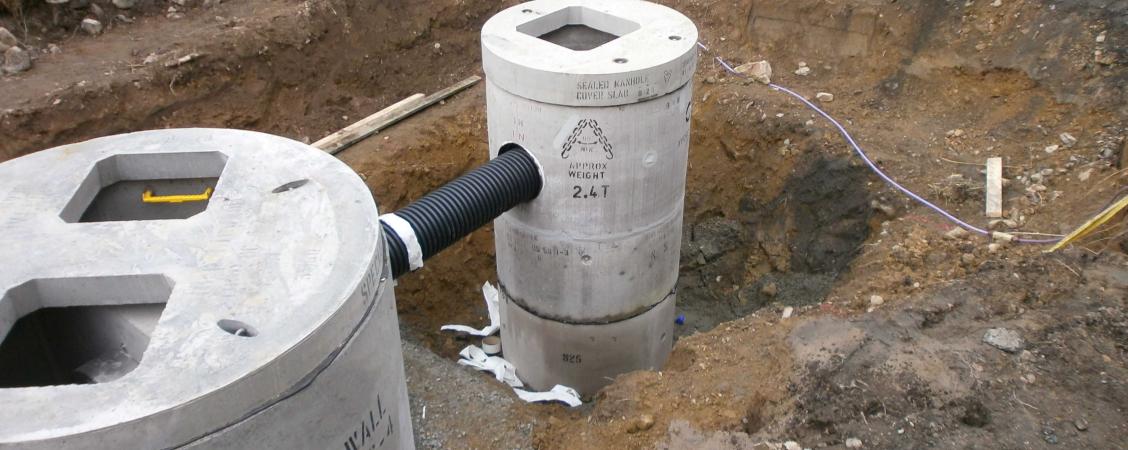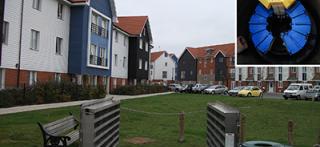
Raising a Toast to SuDS on a Steep Scottish Mountain Highway
Potential road safety problems on the A95 have been tackled with an imaginative SuDS Solution from Hydro International.
Situation
Poor drainage, flooding and freezing weather had led to a landslip and extreme surface degradation along a section of the narrow A95 that descends on a 10% gradient with tight bends to the picturesque village of Craigellachie on the River Spey, near Elgin.
Located immediately above the River Fiddich, a tributary of the River Spey and a Special Area of Conservation, the area is also world-renowned for the production of single malt whisky and is an important salmon fishery. Control of any surface water runoff would therefore have to include measures which maintained the clarity and purity of the water.
Under the Water Environment (Controlled Activities) (Scotland) Regulations 2011, the drainage from major roads must be subject to control of any diffuse pollution to help meet the objectives of the EU Water Framework Directive. There were also concerns on the potential of the reconstruction work affecting the water environment, so care was needed to prevent any accidental pollution.
Other restrictions, under the General Binding Rule 10 of The Scottish Environment Protection Agency (SEPA), stipulate that any road construction must be drained by a SuDS scheme to ensure flow and pollution control. SEPA Pollution Prevention Guidelines 5 and 8 carefully regulate works which could affect water and look for at least two forms of treatment to the surface water runoff.
“The road is cut very tightly into the hillside, which limits the construction space along much of the stretch of road although there is a small lay-by set into the hillside around the middle of the scheme. There are also a minor road and farm entrance which complicate the road drainage solutions,” Darren continues.
Solution
The solution incorporated three Hydro-Brake® Flow Controls which are installed within weir wall concrete chambers along a pipeline under the road with the last one being located at the downslope end of the pipeline, in front of the Hydro Downstream Defender®.
By working with Hydro International’s stormwater design team, BEAR Scotland specified a long term surface water drainage solution which delivered control of surface water flows and reduced any potential pollution from hydrocarbons into the watercourses below. The solution incorporated three Hydro-Brake® Flow Controls within pre-cast concrete weir wall chambers and a Downstream Defender® hydrodynamic vortex separator.
Investigations as part of Transport Scotland’s upgrade of this section of the A95 Aviemore to Keith Trunk Road, revealed that surface water flowing down the steep hillside had been infiltrating the road foundation structure along the 0.9 km stretch near Craigellachie. The water flow had been washing away the aggregate layers and causing a loss of load bearing capacity, leading to premature wear, edge deterioration, and in one location a landslide that resulted in a retaining wall being constructed.
Winters can be quite extreme in the Cairngorms,” said Darren McLennan, Senior Engineer, BEAR. “Water freezing inside the road structure creates all sorts of problems. Just addressing the road reconstruction without considering the water flow would have resulted in the erosion problem recurring in a few years time. We also couldn’t afford to have the water flowing over or under the road structure which could create icing problems in the winter or the risk of further landslips.
An existing short retaining wall and a series of ditches were proving inadequate, especially as rainfall intensity is increasing with climate change.
Simply improving the ditch volume and water retention with a conventional approach such as cast concrete channels was not an option due to space within the highway boundary. Also, the lack of flow control would risk additional sediment being washed into the river.
Because of the gradients, surface area and other site characteristics, the volume calculations were complex. Hydro International was able to design a minimal maintenance SuDS solution providing the required levels of treatment and combining effective flow control with efficient removal of sediments and any hydrocarbon contaminants.
The basis of the project, undertaken by contractor, the Coffey Group, was to excavate and deepen the existing ditches. These were lined with heavy duty polyethylene to prevent seepage into the road structure then filled with carefully graded filter drain aggregate. Flow through the new channels is limited by a series of check dams before eventually discharging into a new pipeline constructed under the road.
The water flow in the pipeline is controlled by a series of three Hydro-Brake® Flow Control devices, located at 300 metre intervals in weir wall concrete chambers under the road. The controlled discharge of the maximum design flow of the Hydro-Brake® units also enables the pipeline to be used as a temporary storage chamber to help mitigate storm events.
The last of the three Hydro-Brake® units is located at the downslope end of the pipeline, in front of the Downstream Defender®. This device ensures high sediment retention even during storm events, with no re-entrainment, while controlling floatables and providing hydrocarbon separation. The Downstream Defender® discharges over a reinforced rip-rap face set into the embankment to control erosion, and then to the river.
Outcome
The new stretch of the A7 between Carlisle and Langholm has been built to replace the original winding trunk road which had no overtaking opportunities and a poor accident record. The Hydro Downstream Defender® is the first to be constructed on Transport Scotland’s trunk road network.
Keeping the environmental impact of the scheme to a minimum was a key consideration for the council and Transport Scotland. A SuDS-compliant drainage solution was one of a range of strict environmental requirements, including measures to facilitate the movement of fish and mammals, preserve habitats and provide sympathetic landscaping. As part of the project, the original road is to be de-trunked and part of it converted into a cycle path.
The result is an elegant solution which meets both the environmental concerns and the serious structural problem," said McClennan. “As the purity of water in the catchment is very important, and the safety of the infrastructure is greatly improved, we have achieved a good result.































